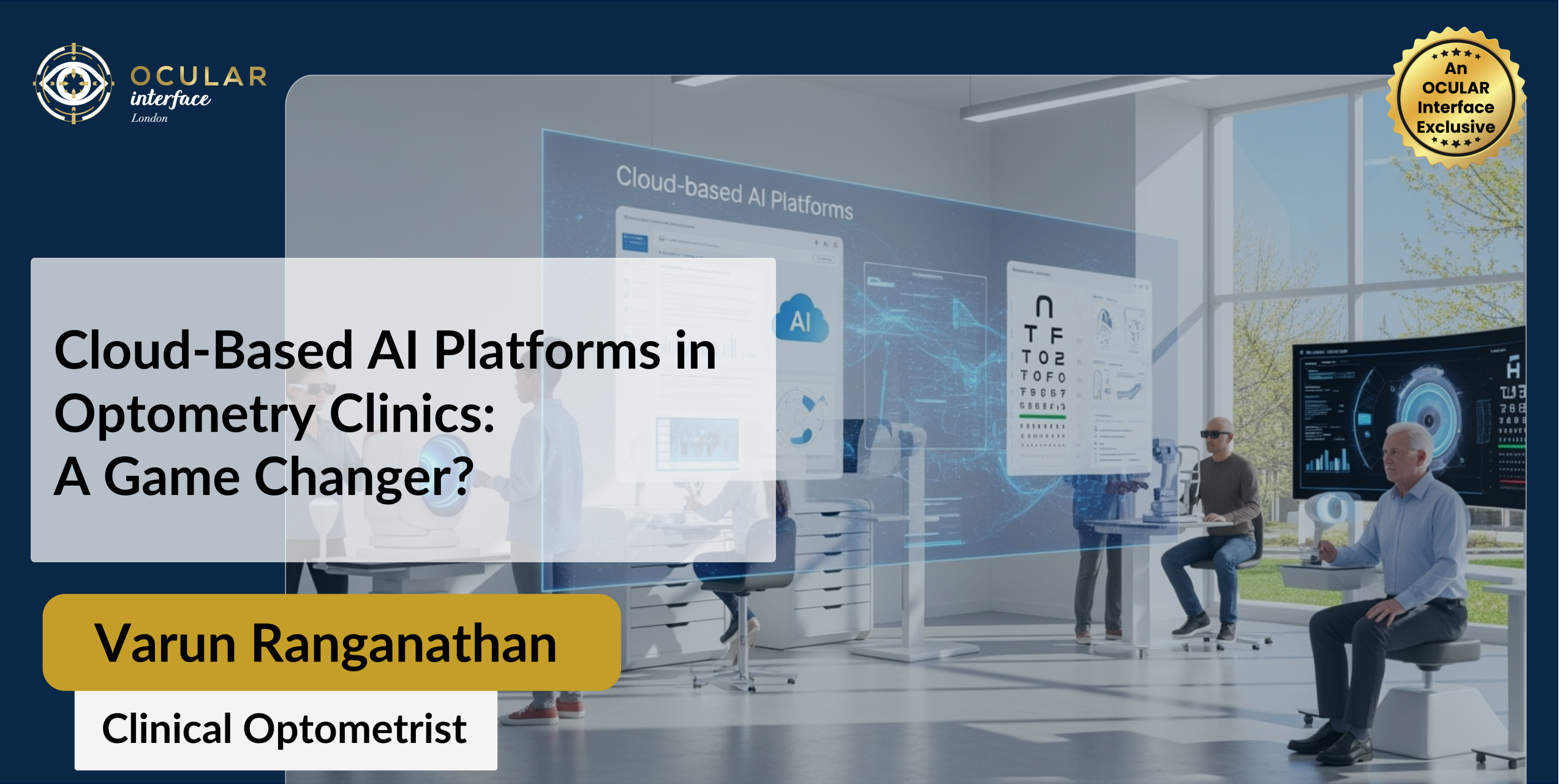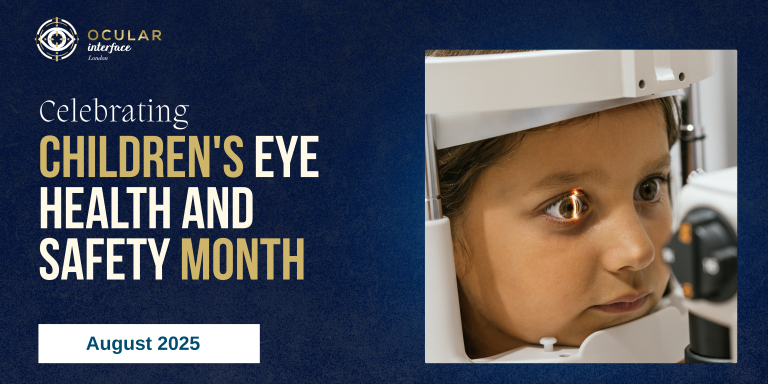Varun Ranganathan, MCOptom
Clinical Optometrist
An OCULAR Interface Exclusive
The cloud is changing how healthcare teams store data, share images and deliver services — and optometry is no exception. Cloud-based artificial intelligence (AI) platforms promise to bring fast, scalable image analysis, remote triage and decision-support right into primary eyecare settings. But are they truly a game changer for optometry clinics, or simply the latest technology trend? This article looks at the benefits, real-world examples, practical considerations and the challenges clinics should weigh before adopting cloud AI.
What is cloud-based AI platforms?
Cloud-based AI platforms host algorithms and data processing in remote, centrally maintained servers (the “cloud”) so clinics can upload images (retinal photos, OCT scans) and receive automated analyses, risk scores or triage recommendations without heavy local computing infrastructure. This model differs from on-device or local software because updates, model improvements and multi-centre learning are managed centrally — enabling continuous improvement and easy scaling across many clinics.1
Why optometry clinics are interested
There are three practical reasons optometry teams are excited about cloud AI:
Cloud AI can flag referable disease (e.g. diabetic retinopathy, AMD, glaucoma suspects) from routine photos, helping primary-care sites triage patients and prioritise referrals. This expands the screening footprint beyond specialist centres. 2Clinics don’t need powerful local servers or complex maintenance; the vendor handles updates and model retraining in the cloud. That makes advanced analytics accessible to smaller practices. 3Cloud platforms can push model updates, security patches and new features centrally; improvements benefit every connected clinic almost immediately. This “one-to-many” advantage accelerates uptake. AI models have been validated for a range of ocular conditions. Landmark studies have shown deep learning can detect referable diabetic retinopathy and related disease with high sensitivity and specificity in multi-ethnic datasets, demonstrating utility for screening programmes that could be delivered via cloud platforms.4
Cloud implementations and research prototypes also exist. Examples include cloud-hosted OCT and fundus screening platforms developed to detect multiple retinal anomalies at scale, and projects that route scans from community clinics to central AI services to prioritise specialist review. These deployments highlight how cloud AI enables broad screening coverage, especially where ophthalmic specialists are scarce.5
Beyond eye disease, retinal images analysed by AI have shown promising signals for systemic risk markers (e.g. cardiovascular risk), suggesting cloud platforms could one day multiplex ocular and systemic screening from a single image — an intriguing future direction for optometry services.
Practical benefits for clinic workflows
When integrated sensibly, cloud AI can:
Speed triage — automated reports identify urgent cases, so reception or the clinician knows who needs fast referral.
Standardise reporting — algorithms apply consistent grading criteria, reducing inter-grader variability.6
Enable remote care pathways — images taken in clinics, community hubs or outreach camps can be analysed centrally and used to trigger teleconsultations or referrals. This supports wider, equitable screening programmes.7
Key concerns and how to manage them
Data protection & regulation
Patient data crosses networks and is stored off-site — so clinics must ensure vendors meet local data-protection rules (GDPR in the UK/EU) and applicable health-data guidance. In the UK, NHS cloud guidance and related security frameworks outline requirements for cloud use in health and social care; private clinics should follow equivalent standards, run data-protection impact assessments and use vendors with robust certifications.8
Clinical validation & generalisability
Models trained on specific populations may underperform others. Clinics should ask vendors for external validation studies in populations like their patient base and seek transparency about training data diversity and performance metrics.9
Integration with workflow
Seamless integration with practice management systems, imaging hardware and patient records is crucial — otherwise AI becomes an extra administrative step, not a help. Choose platforms offering simple upload routes, structured reports and clear referral pathways.10
Limitations the human factor
AI excels at pattern recognition but lacks clinical context, patient history and nuance. Ultimately, it is a tool to augment professional judgement rather than replace it. Careful governance, clinician oversight and patient communication are essential to preserve trust and safety. Also, health-economic evidence and reimbursement models for AI workflows are still evolving — clinics should consider cost, downstream referral burden and local commissioning arrangements.11
The verdict: is it a game changer?
Cloud-based AI platforms hold real potential for optometry clinics: they can democratise access to advanced image analysis, streamline triage and support population screening — especially where specialist services are sparse. When adopted thoughtfully — with attention to data security, clinical validation and workflow integration — cloud AI can be transformational. But clinics should avoid hype, demand robust evidence for local use, and keep patient safety and clinician oversight at the heart of any deployment.12
References
- Abràmoff MD, et al. Pivotal trial of an autonomous AI-based diagnostic system for detection of diabetic retinopathy in primary care offices. NPJ Digital Medicine. 2018. Nature
- Gulshan V, et al. Development and validation of a deep learning algorithm for detection of diabetic retinopathy in retinal fundus photographs. JAMA. 2016. JAMA Network
- Ting DSW, et al. Development and validation of a deep learning system for diabetic retinopathy and related eye diseases. JAMA. 2017. JAMA Network
- Poplin R, et al. Prediction of cardiovascular risk factors from retinal fundus photographs via deep learning. Nature Biomedical Engineering. 2018. Nature
- Chen SY, et al. Artificial intelligence technology in ophthalmology public… (review) 2025. PMC
- Li Z, et al. Artificial intelligence in ophthalmology: The path to the real-world. 2023 (review). PMC
- Blair JPM, et al. Development of LuxIA, a cloud-based AI diabetic retinopathy screening tool. Translational Vision Science & Technology. 2023. tvst.arvojournals.org
- Chen X, et al. An Artificial Intelligence Cloud Platform for OCT-based Retinal Anomalies Screening (AI-PORAS). 2025. Nature
- Chia MA, et al. Benefits of integrating telemedicine and artificial intelligence. (Telemedicine review) 2022. PMC
- Anton N, et al. Comprehensive review on the use of artificial intelligence in ophthalmology. 2022. PMC
- NHS Digital. Cloud security guidance & NHS cloud policies. 2025. NHS England Digital+1
- Brown JM, et al. Automated diagnosis of plus disease in retinopathy of prematurity using deep convolutional neural networks. JAMA Ophthalmology. 2018. PMC










